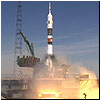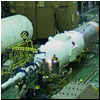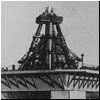Soyuz launch facilities in Baikonur (original) (raw)
Space center in Baikonur originated as a test launch site for the R-7 ICBM developed at Sergei Korolev's design bureau. On September 15, 1955 the construction crews started digging the flame duct for the R-7 launch pad. The participants could only guess about real purpose of their efforts, so among soldiers, the construction site would become known as "stadium." The first R-7 rocket blasted off from Site 1 in Tyuratam on May 15, 1957. The world's first artificial satellite was launched from the same pad on October 4, 1957. After the launch of the first manned spacecraft, Vostok-1, in 1961, the pad at Site 1 was nicknamed "Gagarinskiy Start" (Gagarin's pad). As of Year 2000, 400 launches have been conducted from the pad.
Site 2: Processing and residential area
The residential area and assembly buildings for the R-7 rocket and its derivatives located at Site 2. The early construction here started in 1956. In May 1957, the workers started the erection of the new new assembly and processing building at Site 2A. It also included water-treatment and boiler complex and a special storage apparently for nuclear warheads. The Site 2A complex was completed in July 1958.
At the end of 1958, a year-and-half after the R-7 ballistic missile started flying, the second launch complex for the same rocket was founded at Site 31, east of the original launch facilities in Tyuratam. Unlike the test launch complex at Site 1 and 2, the Site 31 was planned as an operational and training "battle station" for the R-7 missile. As the R-7's role as a carrier of the nuclear weapons diminished, the Site-31 along with Site-1 was re-purposed for space operations, including manned launches.


Multi-media collection
Video
- Soyuz TM-32 rollout video from the assembly building to the launch pad. Date: 2001 April 26; Size: 752 K; Duration: 30 sec.
- Site 1 overflight video with the Soyuz TM-32 on the pad. Date: 2001 April 27; Size: 788 K; Duration 32 sec.
- Soyuz TM-32 blastoff video from Site 1 launch pad. Date: 2001 April 28; Size: 588 K; Duration: 42 sec.
Virtual reality
This unique 360-degree panorama was stiched out of dozen of images taken from a hill top at Site 2 in Baikonur in the early hours of April 26, 2001, as sun was rising in the east, right behind Site 1, better known as Gagarin's pad. The Vostok-1 spacecraft with the world's first cosmonaut was launched from here 40 years earlier. The Soyuz rocket processing facilities could be seen to the south and the Energia-Buran launch complex lay to the northwest.
- Soyuz launch facilities virtual reality panorama (Quick Time VR). Date: 2001 April 26; Size: 724K
- Low-resolution photographic composite. Date: 2001 April 26, 2,000 x 120 pixels / 48K
Facilities overview
| Site | Complex designation | Completion date | Purpose/Infrastructure | Details |
|---|---|---|---|---|
| 1 (PU-5) | 17P32-5 | 1957 | R-7/Sputnik/Vostok/Soyuz launch pad | In service |
| 2 | - | 1957 | MIK 2-1 and extension 1A processing area for R-7 based launchers and their payloads. | 1A extension was completed in mid-1970. The entire facility abandoned in mid-1990s, the Soyuz/Progress processing moved to Site 254 |
| 2A | - | 1958 | MIK 2A processing area for the warheads of the R-7 ICBM. | - |
| 2B | - | - | MIK 2B-1 (135R) processing area for R-7 based launchers and their payloads. | MIK 2B-1 (135R) is used for the integration of the Soyuz and Progress spacecraft with the launch vehicle. The operations are expected to be moved to Site 112 |
| 31 (PU-6) | 17P32-6 | 1960 | R-7/Molniya launch pad | Originally built as the R-7 battle station. Modified for Soyuz-Fregat launches |
| 32 | - | 1960 | R-7 residential housing, assembly buildings MIK-32 and MIK-32GCh | - |


